Learning Stories
Through inquiry-based learning, we witness our learners’ journey unfold, each step marked by curiosity, exploration, and profound discovery. This documentation of learning stories shows their evolving understanding of the world, capturing their triumphs, insights and growth milestones.
Key Concepts: Communication, Health, Change
Teacher’s voice: We are what we eat! But, What do we eat? The time for lunch becomes a space of relations and encounters with others and the world. Children also wonder through their facial expressions why their platter has so many textures, tastes and colours. From this context, our inquiry was born made of experiences, languages and thoughts.
Big Idea: What is Food?
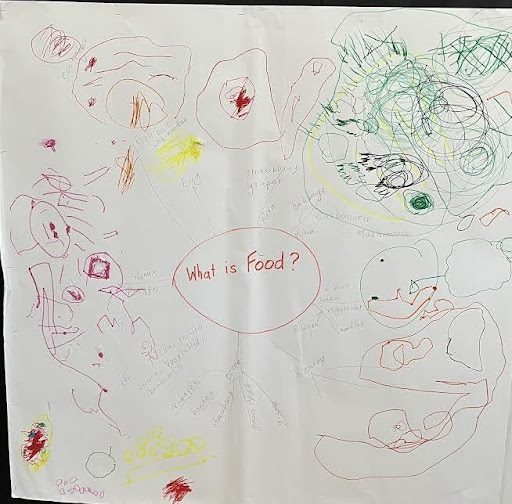
Ziyuan: Things that will make you full… like bread
Language of Drawing
Reflection: The children were challenged to think about what comes to their mind based on the above question and express it through the language of drawing. I recorded their responses as they drew.
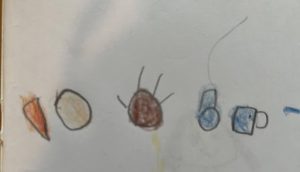
Elizabeth: Food is pizza, tomato sauce, vegetables
Communication and Language Development
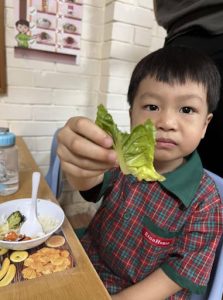
Michael: I eat my food… but why lettuce?
Nana: I don’t know the name, is this breakfast or lunch?
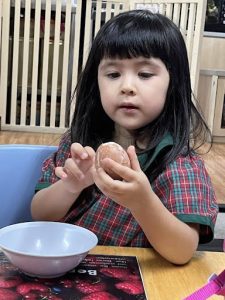
Other questions we hear from the class;
- Why is there a lettuce in my meal?
- Is it breakfast or lunch? – Association of time with food
- How do I open this egg? – Finding out different techniques like peeling, cutting foods
Introduction to ‘My Healthy Plate’ (Names of the food groups, food, sorting)
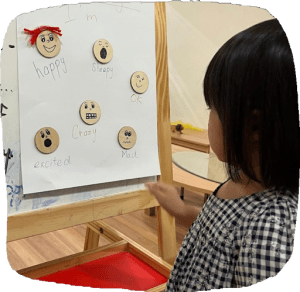
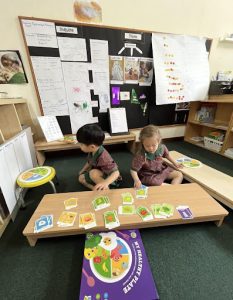
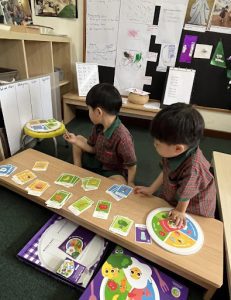
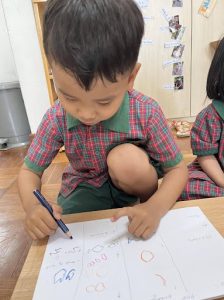
James keeps track of his daily food intake to check if it has whole meals, proteins, fruits, and vegetables.
How healthy is my school food?
Language of Mathematics & Language and Literacy
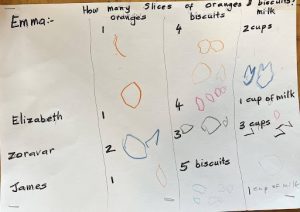
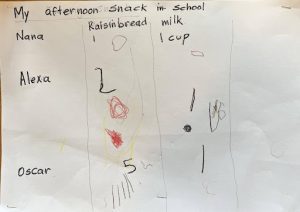
Our daily school meals – Count and measurements
Reflection: Children acquired knowledge through learning new vocabulary (names of the food groups) and documenting their food intake every day through the language of drawing and by writing numerals. Children visually compared and discussed with each other how healthy is their daily meals.
What’s in your bowl? – Recreating the collected data
Language of Clay
Reflection: The next material we used to further unpack this inquiry is clay. Children used tools to make marks and incisions on the clay and took ownership by creating characters and objects to represent their thoughts and ideas.
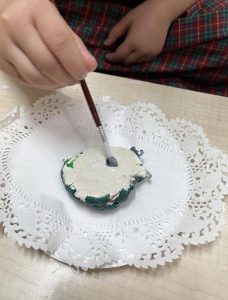

Ziyuan: Broccoli…
Yi Zheng: Cutting my chicken
Louisa: Cutting clay for fruit
Alexa: I am cutting the banana into small pieces
Classification of food items
Understanding the ingredients in our daily school lunch preparation
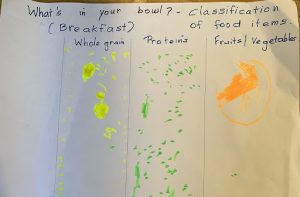
James: Orange is a fruit!
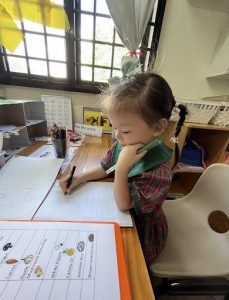
Nana: What are these, Miss Alice?
Miss Alice: These are the ingredients which are used to prepare our lunch
What is an ingredient?
Language of Cooking
Evaan: Ingredients means putting the things together to make a cupcake.
Question: What are the ingredients for choc chip cookies?
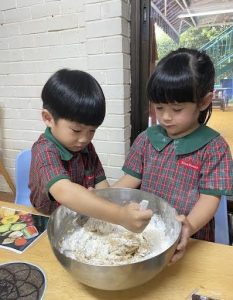
Evaan: Choc chips, sprinklers, banana, butter…
Recipe by Allegra: Some butter, some oil, and flour, put it in the oven…, and turn on the light.
Oat Cookies recipe by Isabelle:
Peel banana, put oats, mix… Put choc chips mix…
Put sprinklers mix… Put in the oven… Oven is cooking.
Reflection: Children are ‘making connections’ to ingredients and Recipes here… Making connections is a critical part of learning. The connections take place when children create personal meaning with what they are learning.
What are the ingredients in my school lunch today?
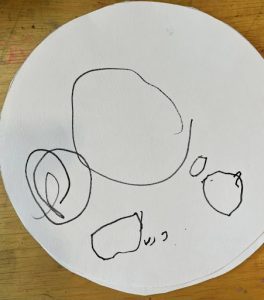
Zoravar: Today’s lunch is Tomatoes, Chicken, green cucumber and Rice… I think the lemon ingredient made the chicken sweeter… They used the water to make the chicken watery… And Cheddar to make it crunchy.
Reflection: When children’s voices are so detailed with food vocabulary describing the taste, texture and the process, we know how deeper this inquiry is going with the children’s engagement.
Who is preparing the school lunch?
Introducing new vocabulary – ‘Chef’
Miss Alice: Who cooked the lunch for us?
Allegra: School Aunty…
Miss Alice: Our school Chef cooked the lunch for us.
Zoravar: Who is our school Chef?
How do we know it is Lunch Time?
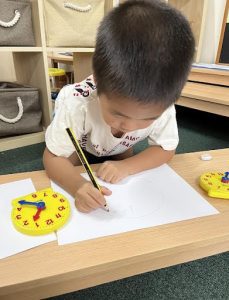

Yi Qi: big hand 1… eat lunch!
Allegra: The clock has 3 hands…small hand points to 11… 11’o clock.
Reflection
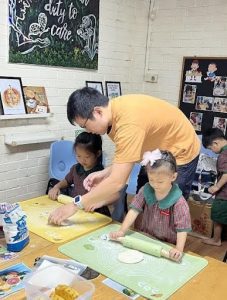
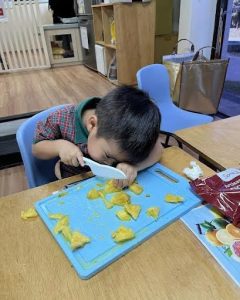
- Children used words to clarify each other during brainstorming about the Language of Food.
- Understood the different processes involved in cooking – Recipe, ingredients, baking in the oven.
- Demonstrated social skills like Team membership and confidence during the inquiry.
- Asked questions, interacted and waited for each other’s response.
Take Action
Children’s interactions with the provocations:

Emma: clock to see what is the time to play, eat lunch, sleep, go home… (Time relationships)
Isabelle: Cut the fruits into slices, cubes and small pieces (Observational skills, Language skills)
Josiah: I can cut the fruits now… (Confidence)
Louisa: I know how to bake…cookies with my mama (Comparative description)
Global Classroom Collaboration with EtonHouse Harbin Pre-School Qun Li
Big Idea: Through discovery and invention people develop an understanding of how the world works (Exploring our Environment)
Possible research questions:
- Architecture: Traditional vs contemporary architecture in Singapore
- Culture and Traditions: Exploring the different cultures in Singapore/ friends of different cultural background in class
- Exploring influences from different parts of Singapore’s past, as well as the modern-day structures. (e.g. Peranakan houses, colonial buildings, traditional homes on some of the islands, Chinese temples etc.).
- Collaboration with the children of Harbin -build friendship with each other (e.g. pen pals) where they could email/ draw or write letters to each other
The difference between traditional and contemporary architecture found in Singapore
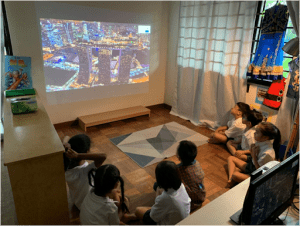
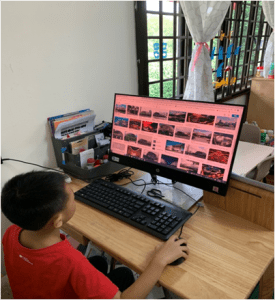
The children went on to find out the differences between traditional architecture and contemporary architecture:
- The period they were built (when)
- What they notice about the design, pattern and size
- Why are they different?
- The different styles of building
Reflection: The children learnt architecture in Singapore displays a range of influences and styles from different places and periods. This includes vernacular traditional shophouses as well as colonial civic and commercial architecture. They begin to differentiate the different types of buildings.
Collaborating with Harbin – Exploring Famous Landmarks
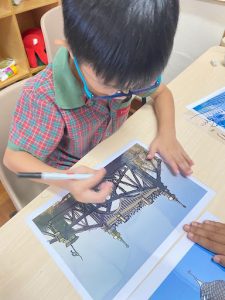
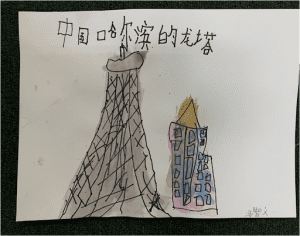
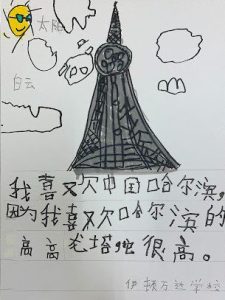
The children collaborated with the children of Harbin, China to explore its architecture. They explored some of the famous structures like the Sophia Cathedral, Yang Ming Tang Bridge and Ice City.
They express and translate what they see of this architecture through pictures and different forms of drawing concepts like tracing, representational drawing, and symmetry drawing.
Expressing Singapore Architecture through different languages
Language of Drawing
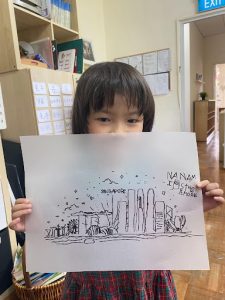
Drawing of Singapore’s modern architecture through tracing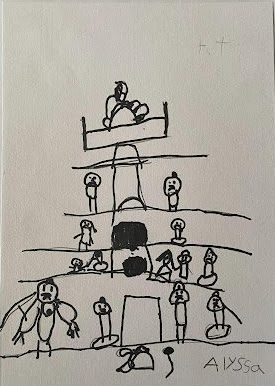
Exploring the traditional architecture of an Indian Temple using a black marker
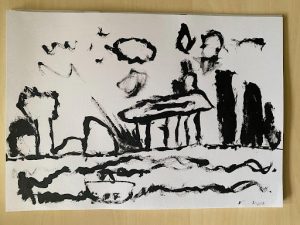
Exploring contemporary architecture through black ink painting
As the class looked deeper into Singapore’s two types of architecture, the children began representing them through various languages and mediums. Through this, children get to see the work and the knowledge they bring to the subject of Singapore Architecture. They learnt new vocabulary words as well as the concept of architectural style, lines, forms, colours, shapes and the different periods, e.g. vintage and modern.
Language of Projector
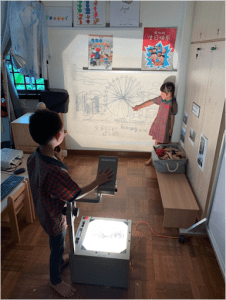
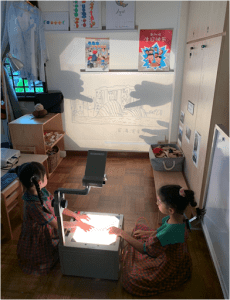
Sharing their architectural drawings through the overhead projector
Language of Mix Media
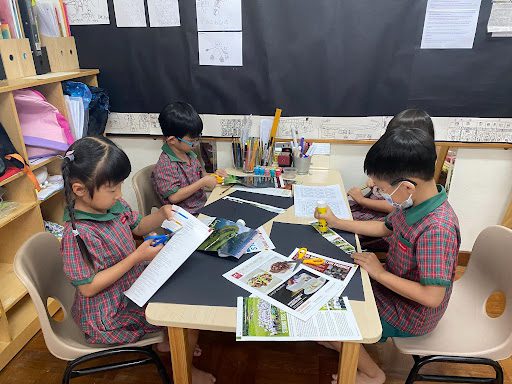
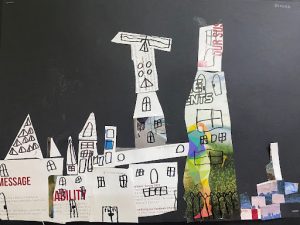 Collage creation of architecture using magazines
Collage creation of architecture using magazines
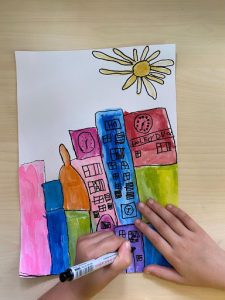 Exploring the skill of overlapping drawings
Exploring the skill of overlapping drawings
The children represented what they have learnt about traditional and contemporary architecture through different materials and mediums in the form of visual art – developing their creative thinking process.
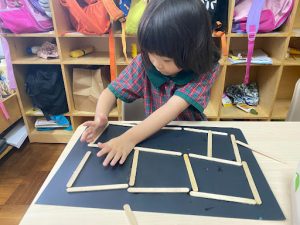
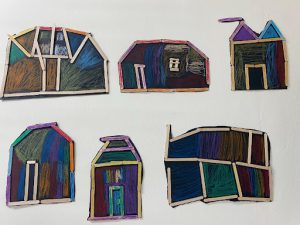
Designing buildings and houses using popsicle sticks with oil pastels on black paper
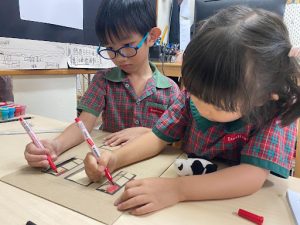
Challenging with cardboard to create a 2D shophouse
Language of Cardboard

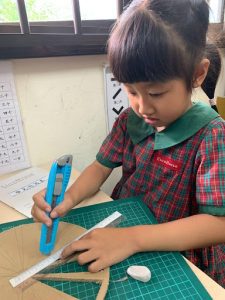
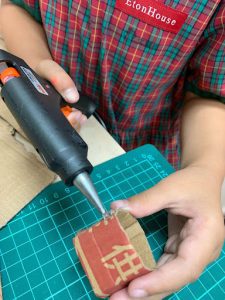
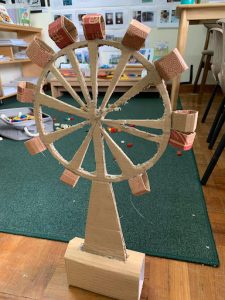 Building a 3D ferris wheel using cardboard
Building a 3D ferris wheel using cardboard
Language of Sand
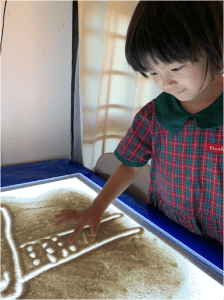
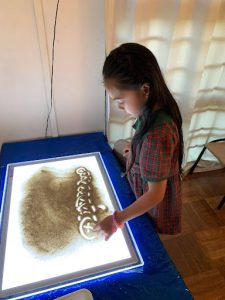
Creating sand art by capturing the beauty of Singapore’s iconic buildings through the sand and reflection of light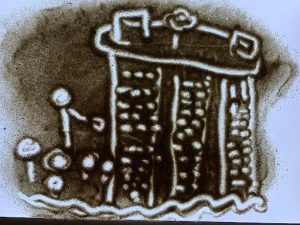 Representation of Marina Bay Sands
Representation of Marina Bay Sands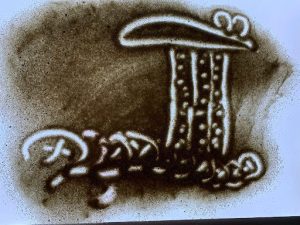 Representation of Helix Bridge
Representation of Helix Bridge
Language of Clay
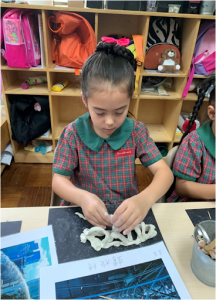
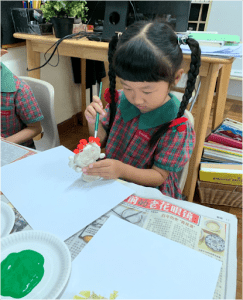
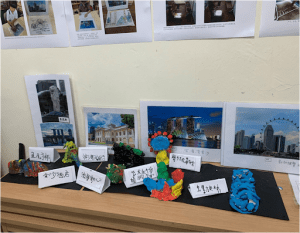
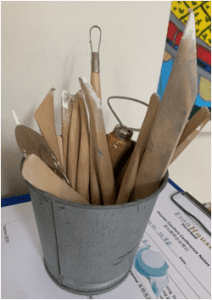
Usage of clay and clay tools to design architectural structures
What can you find in a city?
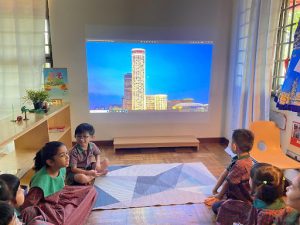
After exploring Singapore and Harbin, the children were invited to think and plan a city of their own and what they would take from these two cities and create their own.
Joshua: We need a hospital.
Bixuan: Also a hotel…
Daniel: There needs to be roads and highways for cars.
Jasper: A city also needs to have shopping malls and other buildings (business buildings)
What is a blueprint?
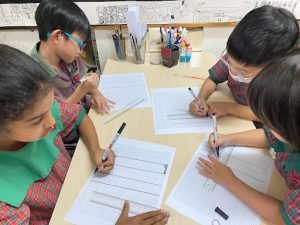
The children learnt the concept of a blueprint and the purpose of a blueprint when planning and designing a building/city. We looked at the following questions as the children explored:
- Why do people need to draw plans to build a building?
- What is needed to create a blueprint drawing
- What is the next step after creating a blueprint?
Can you create a city inspired by Singapore & Harbin? Through the language of drawing
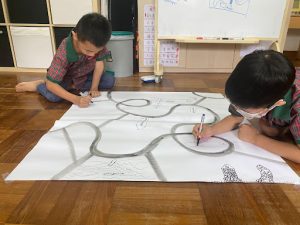
The children moved on by learning how to create their own city, inspired by Singapore’s architecture. Each child had their own interpretation of their architectural experience. Their renders demonstrate what they know, and their style represents who they are through creative thinking and innovation.
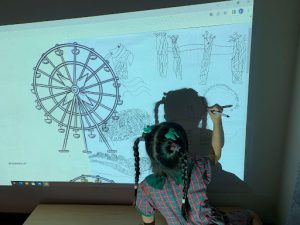
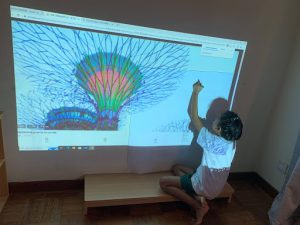 Designing their cities with the help of projectors and computers
Designing their cities with the help of projectors and computers
Exploring the Language of Paper & Construction
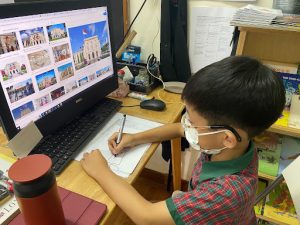
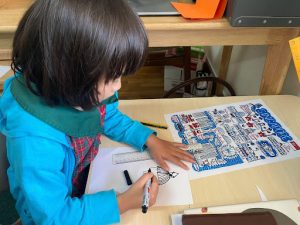
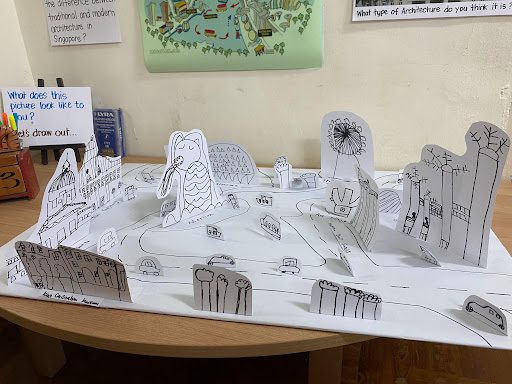
The children were involved in developing a 3D pop-up map of the City Hall Area of Singapore. This involved studying the map and the geographical location of the landmarks and structures and placing them according. The entire project was done with paper and black markers. The children learnt the skills of map reading, labelling, drawing with intricacy and details, problem-solving, and logical and critical thinking.
Language of Paper & Construction – Building our Paper City
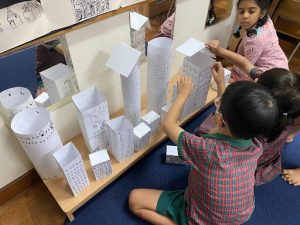
Exploring basic architecture concepts and stretching their imagination into 3D with paper folding and building techniques.
Collaboration with Friend of Harbin – Writing Letters
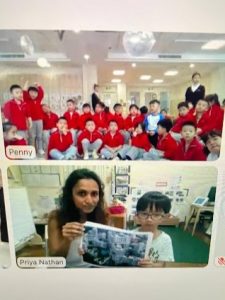
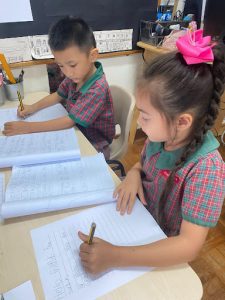
The children also made connections to their learning by forming friendships with the children of Harbin by writing a letter to them describing Singapore. Through this experience, they learnt the concepts of letter writing and the important functions of grammar and punctuation in forming sentences. They followed these guidelines to create their letter:
- Introduction of themselves
- Interesting fact about Singapore
- Where do they love visiting most and why
- A question for the children of Harbin about where they stay
Messages for our Harbin Friends

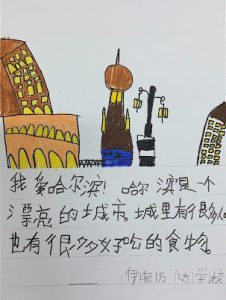
Reflections
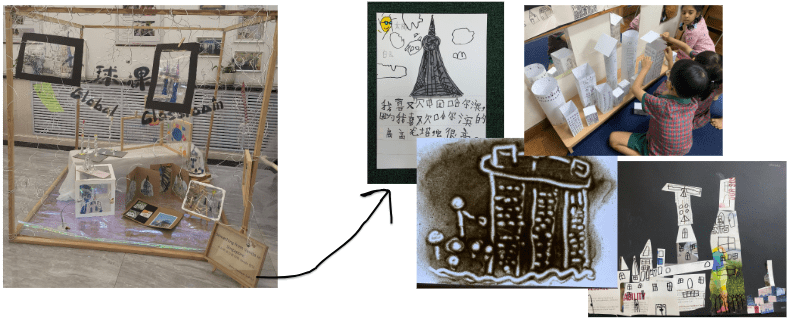
We thank Miss Priya and Miss Wu for assisting us in conveying messages from the international classroom to the children through twice-weekly online meetings. In the Harbin campus, there is a designated area for the Vanda campus, where ideas, language, and works from Vanda’s children are shared.
Miss Priya: Collaborating with Harbin China has given me the opportunity to view the concept of learning through a new lens. The children had a meaningful opportunity to explore learning through connecting with friends from Harbin, China. They could explore deeper into Singapore’s architecture and make connections with their friends from China. It has allowed us to broaden our perspectives and mindsets.
Jasper: I learnt a lot about Singapore Architecture
Bixuan: There are so many types of buildings, and we wrote letters to our friends in Harbin.
Nanami: I like the Ice City!
Miss Wu: 滨一起参加全体课堂的项目。通过这次跨国交流,让孩子们了解中国哈尔滨美丽的建筑物和美味的食物,例如:龙塔、冰城。通过硬片、视频连线等项目进行探索活动,缩短了两国之间的距离,让孩子们近距离地了解哈尔滨这座美丽城市的文化背景,促进了双方的交流和合作,开拓孩子们的全球化视野。